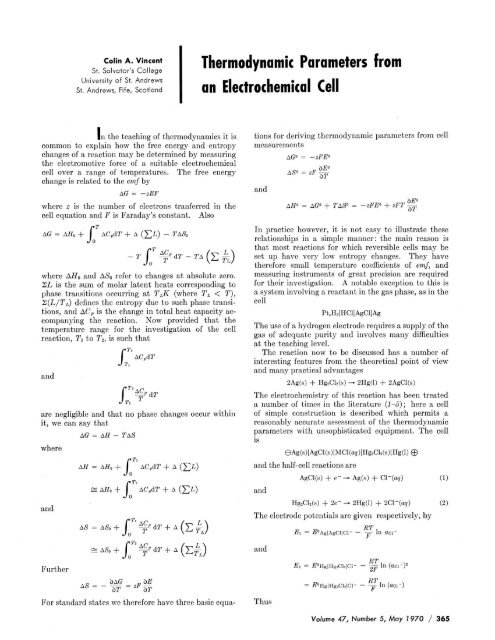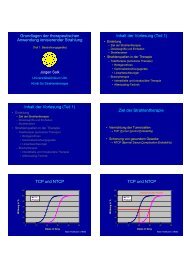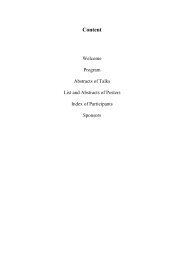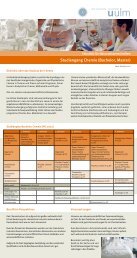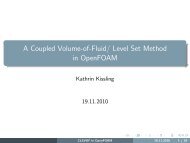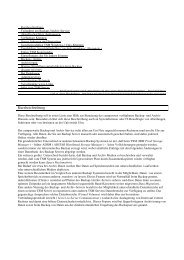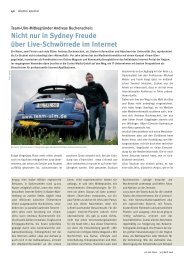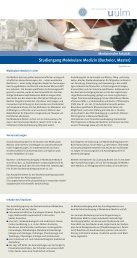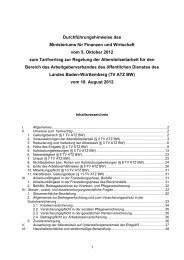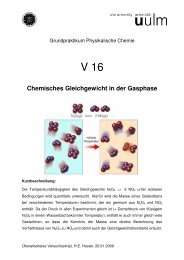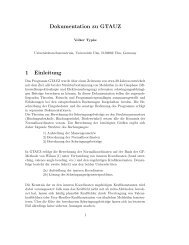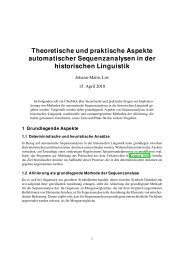Vincent_JCE1970p0365..
Vincent_JCE1970p0365..
Vincent_JCE1970p0365..
You also want an ePaper? Increase the reach of your titles
YUMPU automatically turns print PDFs into web optimized ePapers that Google loves.
I Colin A. <strong>Vincent</strong><br />
St. Salvatorts College<br />
1 University of St. Andrews<br />
st. Andrews, Fife, Scotland<br />
In the teaching of thermodynamics it is<br />
common to explain how the free energy and entropy<br />
changes of a reaction may he determined by measuring<br />
the electromotive force of a suitable electrochemical<br />
cell over a range of temperatures. The free energy<br />
change is related to the emf by<br />
where z is the number of electrons tranferred in the<br />
cell equation and F is Faraday's constant. Also<br />
where AHo and ASo refer to changes at absolute zero.<br />
ZL is the sum of molar latent heats corresponding to<br />
phase transitions occurring at T,K (where TL < T),<br />
Z(L/T,) defines the entropy due to such phase transitions,<br />
and AC, is the change in total heat capacity accompanying<br />
the reaction. Now provided that the<br />
temperature range for the investigation of the cell<br />
reaction, TI to T%, is such that<br />
ST: Ac-~T<br />
and<br />
are negligible and that no phase changes occur within<br />
it, we can say that<br />
where<br />
and<br />
Further<br />
AG = AH - TAS<br />
For standard states we therefore have three basic equa-<br />
Thermodynamic parameters from<br />
an Electrochemical Cell<br />
tions for deriving thermodynamic parameters from cell<br />
measurements<br />
and<br />
AGO = -zFEo<br />
bEO<br />
AS* = LF --<br />
bT<br />
In practice however, it is not easy to illustrate these<br />
relationships in a simple manner: the main reason is<br />
that most reactions for which reversible cells may be<br />
set up have very low entropy changes. They have<br />
therefore small temperature coefficients of emf, and<br />
measuring instruments of great precision are required<br />
for their investigation. A notable exception to this is<br />
a system involving a reactant in the gas phase, as in the<br />
cell<br />
Pt,HnlHClIAgClIAg<br />
The use of a hydrogen electrode requires a supply of the<br />
gas of adequate purity and involves many difficulties<br />
at the teaching level.<br />
The reaction now to be discussed has a number of<br />
interesting features from the theoretical point of view<br />
and many practical advantages<br />
2Ag(s) + HgsCIds) - 2Hg(l) + 2AgCKs)<br />
The electrochemistry of this reaction has been treated<br />
a number of times in the literature (1-5); here a cell<br />
of simple construction is described which permits a<br />
reasonably accurate assessment of the thermodynamic<br />
parameters with unsophisticated equipment. The cell<br />
is<br />
and the half-cell reactions are<br />
The electrode potentials are given respectively, by<br />
RT<br />
El = EOA~IA~CIICI- - - In act-<br />
F<br />
and<br />
Volume 47, Number 5, May 1970 / 365
Ed, = & - E,<br />
= EOH~IHC.CI~ICI- - E0i\~~hgc~~ci-<br />
= EOdl<br />
Thc cell emjis independent of the activity of the chloride<br />
ion in solution and is thus unaffected by the chloride<br />
salt used, its concentration, the solvent, and the presence<br />
of other electrolytes, provided that the electrodes remain<br />
reversible solely to the chloride ion.<br />
There are three particular practical advantages of<br />
using this cell for teaching purposes<br />
1) A relat.ively high value of bE/aT coupled withavery small<br />
emf permits sufficiently accurate meawrements to he made with<br />
"stodent!' Poggendorf potent,iomelers by using the potential divider<br />
key in the 0.1 position-i.e., reading 0-170 mV.<br />
2) The electrodes, which are fairly simple to - prepare, - are not,<br />
readily polarized.<br />
3) There is no liquid junction and hence theverydifficult prohlem<br />
of variation of liquid junction potential with temperature is<br />
eliminated.<br />
Experimental<br />
The cell and electrodes are shown in Figure 1. The cell, (C),<br />
consist,^ of a glass U-tube with one wide and one narrow limb.<br />
The wide limb contains the electrodes and cell solution while the<br />
narrow tuhe permits electrical connection to he made to the mer-<br />
cury of the calomel electrode by means of the plstinum wire<br />
contact (Dl.<br />
Figure 1. Cell and electroder.<br />
Calmnrl Elrctrodc. This was prepared aft,er the mrtnner of Hills<br />
and Ives (6). Mercury was chemically purified in the standard<br />
manner and distilled. Mercurous chloride was precipitated from<br />
0.1 M HCl by acidified Hg2(NO&; the precipitate was stirred for<br />
24 hr during which time the HCI was decanted and replaced three<br />
bimes. The cxlomel was filtered, washed, and finally dried under<br />
vacuum. A few milligrams were then taken and shaken with 1<br />
ml of clean mernny ta produce a. calomel "skin!' The cell was<br />
rendered hydrophobic by treatment with "Desicote" liquid (Beckman<br />
Instruments Ltd.) to prevent the so-called "wedge effect"<br />
where cell solution seeping between the mercury and cell walls<br />
produces erratic behavior in the electrode. The electrode was<br />
iiet up by introducing mercury to the cell and then transferring a<br />
nmall amount of the calomel skin to bhe mercury surface, over<br />
which it rapidly spread. The cell solut,ion, normally approximately<br />
0.1 M HC1, was prepared by diluting "AnalaR" hydrochloric<br />
acid with disbilled water. Oxygen was removed from the<br />
solution by passing oxygen-free nitrogen through it. The deoxygenated<br />
solution was then carefully added to the cell with minimum<br />
disturbance of the mercury surface.<br />
SilverISilver Chloride Electrode. Two tvoes of AelAeClIC1-<br />
-, -<br />
were uskd. The first (Fig. 1B) of the thermal-electrolytic type,<br />
proved more reliable over the long term compared wit,h the more<br />
366 / Journal of Chemical Education<br />
easily prepared second type (Fig. lA), formed by the chloridiaation<br />
of silver wire.<br />
The thermd-electrolytic electrodes which have been described<br />
in detail hv Bates (7) and elsewhere. were constructed bv sealine<br />
a small pl~tinum wire spiral into a soda-glass tube in suih a way<br />
that the wire protruded inside the tuhe to form a, mercury contact.<br />
After cleaning the spirals in hailing concentrated HNOs, apaste of<br />
spectroscopicdy pure silver oxide in distilled water was applied to<br />
them. This paste was then dried out in an oven at 90°C before<br />
being reduced to silver at 4SO°C. A further ooat of paste was applied<br />
and the procedure repeated. Each electrode finally cantained<br />
about 60 mg of silver oxide. The electrodes were ehlaridized<br />
by making them the anodes of electrolytic cells containing<br />
preelectralyzed 1.0 M HC1 as electrolyte solution and an isolated<br />
platinum cathode. Using the amperostat described previously<br />
(S), the electrolyses were carried out at a constant current of 10<br />
mA for 800 sec to produce a -15% convemion to silver chloride.<br />
The simpler type of AgjAgCl/Cl-electrodes were prepared from<br />
10 cm of 0.02 in. best grade silver wire. The latter wa wound in<br />
a wide spiral (Fig. 1.4) and then etched by treating it with 5 M<br />
HNO. for 60 sec. The wire was then thoroughly washed with<br />
distilled water before beine soaked in oonoentrated ammonia.<br />
use.<br />
Emjmeasurementk were made with a "portable potentiometer''<br />
(W. G. Pye and Co. Ltd.) which with its range switch at X0.1 had<br />
an absolute accuracv of 3~0.1 mV. A number of results were also<br />
read on a digital voltmeter (Solmtron Electronic Group Ltd.,<br />
type LM1420.2).<br />
The cell wss immersed in a thermostatted bath, the tempers,<br />
ture of which could he regulated to *O.OSDC.<br />
Results<br />
It was straightforward to show that the emf was<br />
independent of the concentration of chloride ion;<br />
nor was it influeuced by the medium. A range of HC1<br />
and KC1 concentrations were studied. Further solu-<br />
tions were made up in dioxan-water mixtures and others<br />
had quantities of NaCIOa added to them. The emf<br />
was unaffected.<br />
While cells with both types of AglAgCIIC1- electrode<br />
maintained constant emf values within better than 0.1<br />
mV for several days, it was found that a number of cells<br />
with type A electrodes (based on silver wire) showed<br />
variations of *1 mV after numerous heating and<br />
cooling cycles. It was essential to ensure that none<br />
of the materials used was contaminated with bromide<br />
or iodide ion. Erratic results were sometimes oh-<br />
tained if the precautions described in the Experimental<br />
section were not carried out.<br />
The mean value for the cell emfat 298'IC was 45.6 mV,<br />
which agrees well with previous measurements (1, 3).<br />
The emf as a function of temperature over the range<br />
15-50°C is shown in Figure 2. Within the accuracy<br />
Figure 2. Typical experimental variation of cell voltage with temperature.
of the present measurements the results may be repre-<br />
sented by a straight line of slope +3.34 X V°K-1,<br />
which is again in agreement with the findings of other<br />
workers. For the reaction<br />
we have<br />
and<br />
Thus<br />
and<br />
Discussion<br />
2Ag(s) + Hg~Ch(8) + 2AgCl(s) + 2Hg(l)<br />
AGO = -zFE'<br />
= -2 X 96,491 X 0.0456<br />
= -8.80kJ<br />
bE0<br />
ASQ = +zF -<br />
bT<br />
= 2 X 96,491 X 3.34 X lo-'<br />
= 64.5 J°K-1<br />
TASo = 19.22 kJ for T = 298'K<br />
Perhaps the main interest in this reaction lies in the<br />
fact that the thermodynamic parameters derived from<br />
the cell measurements refer to pure single components,<br />
and do not involve solution species. Provided that<br />
both electrodes remain reversible and have their po-<br />
tentials determined solely by the chloride ion, what<br />
comprises the solution phase is of no consequence.<br />
Attempts have been made in the past to measure the<br />
emf of the cell in nonaqueous solvents, mainly with a<br />
view to checking the reversibility of the electrodes for<br />
their subsequent use as reference electrodes. Un-<br />
fortunately, irreproducible results were obtained<br />
with acetone (9), acetonitrile (9, lo), and cyclohexanol<br />
(lo), pfobably due to disproportionation of the mer-<br />
curous ion. A constant value of 46.5 mV at 25'C after<br />
an equilibration period has been found with formamide<br />
as solvent (18).<br />
A somewhat unusual feature of the reaction, as is<br />
pointed out by MacInnes (11), is that the enthalpy<br />
change is opposite in sign to the free energy change-<br />
that is to say, the reaction as written is a spontaneous<br />
endothermic process.<br />
The reaction enthalpy may be calculated from stan-<br />
dard heats of formation determined from calorimetric<br />
data (18). Thus<br />
This compares well with the result from the cell, con-<br />
sidering the uncertainty of the thermal data.<br />
The reaction entropy may be derived from standard<br />
entropy values determined from heat capacity measure-<br />
ments together with data on the heat and temperature<br />
of melting of mercury.<br />
At 29X°K we have<br />
Figure 3. Variation of speciflc heat with temperature for silver and<br />
merFUry.<br />
and<br />
Therefore<br />
Sommcl, = 195.8 J0K-' (16)<br />
Again the agreement is very reasonable, since there is<br />
considerable uncertainty in the standard entropy of<br />
calomel, which may be lower than the value here<br />
selected (17).<br />
It may be noted that the standard entropy of two<br />
moles of silver chloride at 29XoI< is almost the same as<br />
that of one mole of mercurous chloride at the same<br />
temperature. Hence the reaction entropy is effectively<br />
that of<br />
Now assuming the absence of phase changes in the solid<br />
state the standard entropy of silver is<br />
and for mercury is<br />
where C, is the molar heat capacity at constant pressure<br />
and L is the molar heat of fusion at T,, the melting<br />
point. For mercury the heat of fusion is 2.295 kJ<br />
mole-' at 234.3'1C (IS) so that the entropy of fusion<br />
is 9.8 J°K-1 mole-I (or 19.6 JOI
300 200 100<br />
r c:n)<br />
Figure 4. Plot of Cp versus T for Hg ond Ag. Shaded orea represent%<br />
mercury and 215'Ii for silver.<br />
In Figure 4 the shaded area corresponds to the 23.6<br />
J0Ii-I mole-' difference in the standard entropy of<br />
the two metals. Using the Einstein or Debye sta-<br />
tistical thermodynamic models of monatomic crystals,<br />
one can explain this difference in terms of the mercury<br />
atoms exerting weaker interatomic forces than the<br />
368 / Journol of Chemicol Education<br />
silver atoms. The mercury thus has a lower character-<br />
istic (or cut-off) frequency of vibration in the lattice,<br />
and more heat may therefore be absorbed by it at low<br />
temperatures.<br />
Literature Cited<br />
(1) GERKE, R. H.. J. Am,. Chem. SOE., 44,1684 (1922).<br />
(2) RANDALL, M., AND YOUNO, L. E., J. AmW. Chem. Soc., 50, 989 (LP28).<br />
(3) Pou~nor~n, J.. AND CHATEAU, I%., Comptm. Rend., 237,711 (1953).<br />
(4) LIET~E, M. H., AND VAUOBAN, J. v., J. Arne,. Chem. Soc., 77, 876<br />
(1955).<br />
(5) Lmmue, M. H.. AND STOUQHTON, R. W.. 3. CHEM. EDUC.. 39. 230<br />
(1962).<br />
(6) HILL^. G. J.. Ann IVEB, D. J. G.. "Referenoe Electrodes." (Editors:<br />
Ivas, D. J. G., hno Jnaz.G. J.), Academic Press. London, 1961, p.<br />
."-<br />
MU.<br />
(7) BITES. R. G.. "Eleotrometric pH Determination," John Wiley & Sona.<br />
Ine..New York, 1954,p.200.<br />
(8) VINCENT. C. A,. AND \\'ARD, J. G.. J. CHEM.EYYC.,~~.~~~ (1969).<br />
(Y) U~rcn, H.. ~~oS~leabz,G. Z.. Z.physih. Chem.. 177,103 (1936).<br />
(10) Knuez. K.. Gosmz. E. P., AND PETERU~LLER, EL. 2. Richtiochem.<br />
1981, 55, 405.<br />
(11) MncINNEa. D. A,. "The Principles of Eleotro~hemistry." Dover Publiestiona,<br />
New York, 1961,~. 114.<br />
(12) LE~IS, G. N.. AND RANDAL= M.. (Revi~ed by: PITZER. K. S., AND<br />
Ilnrwzn, L.) (2nd ed.) "Thermodynamies." MeGrsu,-liill. New<br />
York. 1961,~. 674.<br />
(13) Bus~r, R. H.. AND Guuaa., W. F., J. Amer. Chern. Soc.,75,806 (1953).<br />
(14) EnaTUAN, E. D., rm Wmaen, R. T., J. Chem. Ph~s.. 1,444 (1933).<br />
(15) MEAL?^, P. F., Fonsr~x~. \!'. R., *No Gr~uQum. W. F.. J. Amer. Chem.<br />
-"*., *"" 6, -", ,on" .""" .,A>,<br />
(161 . . Lmtar~n. W. M.. "Oxidatim Potenti&!' . (2nd . ed,. Prentice-Hall. New<br />
york, i052,~.wz.<br />
(17) POGLITZER, F., Z. EleLlroehcm., 19,513 (1913).<br />
(18) Dz Rossl, M., PECCI. G., AND SCROIATI, I>., Rie. Sci., 37, 342 (1967).


